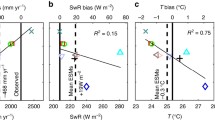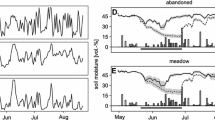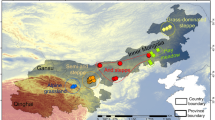Abstract
We examined if climate change in two dry ecosystems—Mediterranean (DME) and Semiarid (SAE)—would cause substantial reduction in the production of annual vegetation. Field measurements and computer simulations were used to examine the following six climate change scenarios: (1) rainfall amount reduction; (2) increases of 10 % in annual evaporation rate and 5 % in annual temperature; (3) increase in magnitude of rainfall events, accompanied by reductions in frequency and seasonal variation; (4) postponement of the beginning of the first rainfall event of the growing season; (5) long dry spells during the growing season; and (6) early ending of the growing season. The results revealed the following outcomes. a) Reduction by 5–35 % in annual rainfall amount did not significantly affect productivity in the DME, but a large (25–35 %) decrease in rainfall would change vegetation productivity in the SAE and lead to a patchier environment. b) Similar results were observed: when temperature and evaporation rate were increased; when the magnitude of rainfall events increased but their frequency decreased; and during a long mid-season dry spell. c) In both ecosystems, changes in the temporal distribution of rainfall, especially at the beginning of the season, caused the largest reduction in productivity, accompanied by increased patchiness. d) Long-term data gathered during the last three decades indicated that both environments exhibited high resilience of productivity under rainfall variability. These results imply that the response of dry ecosystems to climate change is not characterized by a dramatic decrease in productivity. Moreover, these ecosystems are more resilient than expected, and their herbaceous productivity might undergo drastic changes only under more severe scenarios than those currently predicted in the literature.



Similar content being viewed by others
References
Arnau-Rosalén E, Calvo-Cases A, Boix-Fayos C, Lavee H, Sarah P (2008) Analysis of soil surface component patterns affecting runoff generation. An example of methods applied to Mediterranean hillslopes in Alicante (Spain). Geomorphology 101:595–606
Bai Y, Han X, Wu J, Chen Z, Li L (2004) Ecosystem stability and compensatory effects in the Inner Mongolia grassland. Nature 431:181–184
Ben-Gai T, Bitan A, Manes A, Alpert P, Rubin S (1998) Spatial and temporal changes in rainfall frequency distribution patterns in Israel. Theor Appl Climatol 61:177–190
Bradford J, Lauenroth W, Burke I, Paruelo J (2006) The influence of climate, soils, weather, and land use on primary production and biomass seasonality in the US Great Plains. Ecosystems 9:934–950
Cox RD, Allen B (2008) Stability of exotic annual grasses following restoration efforts in southern California coastal sage scrub. J Appl Ecol 45:495–504
Daly C, Bachelet D, Lenihan JM, Neilson RP, Parton W, Ojima D (2000) Dynamic simulation of tree-grass interactions for global change studies. Ecol Appl 10:449–469
Dayan U, Koch J (1999) Implications of climate change on the coastal region of Israel. Mediterranean Action Plan, United Nations Environment Programme
Dore MHI (2005) Climate change and changes in global precipitation patterns: what do we know? Environ Int 31:1167–1181
Frederick KD, Major DC (1997) Climate change and water resources. Clim Chang 37:7–23
Grime JP, Fridley JD, Askew AP, Thompson K, Hodgson JG, Bennett CR (2008) Long-term resistance to simulated climate change in an infertile grassland. PNAS 105:10028–10032
Gunderson LH (2000) Ecological resilience - in theory and application. Annu Rev Ecol Syst 31:425–439
Heisler-White JL, Knapp AK, Kelly EF (2008) Increasing precipitation event size increases aboveground net primary productivity in a semi-arid grassland. Oecologia 158:129–140
Holling CS (1973) Resilience and stability of ecological systems. Annu Rev Ecol Syst 4:1–23
Huxman TE, Smith MD, Fay PA, Knapp AK, Shaw MR, Loik ME, Smith SD, Tissue DT, Zak JC, Weltzin JF (2004) Convergence across biomes to a common rain-use efficiency. Nature 429:651–654
Jensen JR (1996) Introductory digital image processing: a remote sensing perspective. Prentice-Hall Publishing Inc, Englewood Cliffs, p 316
Kafle HK, Bruins HJ (2009) Climatic trends in Israel 1970–2002: warmer and increasing aridity inland. Clim Chang 96:63–77
Kèfi S, Alados CL, Chaves RCG, Pueyo Y, Rietkerk M (2010) Is the patch size distribution of vegetation a suitable indicator of desertification processes? Comment Ecol 91:3739–3742
Lauenroth W, Bradford J (2006) Ecohydrology and the partitioning AET between transpiration and evaporation in a semiarid steppe. Ecosystems 9:756–767
Lemmens C, Boeck HJD, Gielen B, Bossuyt H, Malchair S, Carnol M, Merckx R, Nijs I, Ceulemans R (2006) End-of-season effects of elevated temperature on ecophysiological processes of grassland species at different species richness levels. Environ Exp Bot 56:245–254
Loik ME, Breshears DD, Lauenroth WK, Belnap J (2004) A multi-scale perspective of water pulses in dryland ecosystems: climatology and ecohydrology of the western USA. Oecologia 141:269–281
Ludwig JA, Tongway DJ, Marsden SG (1999) Stripes, strands or stipples: modelling the influence of three landscape banding patterns on resource capture and productivity in semi-arid woodlands, Australia. Catena 37:257–273
Ludwig JA, Wilcox BP, Breshears DD, Tongway DJ, Imeson AC (2005) Vegetation patches and runoff-erosion as interacting ecohydrological processes in semiarid landscapes. Ecology 86:288–297
Lundholm JT, Larson DW (2004) Experimental separation of resource quantity from temporal variability: seedling responses to water pulses. Oecologia 141:346–352
McCarty JP (2001) Review: ecological consequences of recent climate change. Conserv Biol 15:320–331
Muldavin E, Moore D, Collins S, Wetherill K, Lightfoot D (2008) Aboveground net primary production dynamics in a northern Chihuahuan Desert ecosystem. Oecologia 155:123–132
Notaro M (2008) Response of the mean global vegetation distribution to interannual climate variability. Clim Dyn 30:845–854
Noy-Meir I (1973) Desert ecosystems: environment and producers. Annu Rev Ecol Syst 4:25–51
Noy-Meir I, Gutman M, Kaplan Y (1989) Responses of Mediterranean grassland plants to grazing and protection. J Ecol 77:290–310
Oesterheld M, Loreti J, Semmartin M, Sala OE (2001) Inter-annual variation in primary production of a semi-arid grassland related to previous-year production. J Veg Sci 12:137–142
Osem Y, Perevolotsky A, Kigel J (2002) Grazing effect on diversity of annual plant communities in a semi-arid rangeland: interactions with small-scale spatial and temporal variation in primary productivity. J Ecol 90:936–946
Petru M, Tielborger K, Belkin R, Sternberg M, Jeltsch F (2006) Life history variation in an annual plant under two opposing environmental constraints along an aridity gradient. Ecography 29:66–74
Porporato A, D’Odorico P, Laio F, Ridolfi L, Rodriguez-Iturbe I (2002) Ecohydrology of water-controlled ecosystems. Adv Water Resour 25:1335–1348
Ragab R, Prudhomme C (2002) SW—Soil and water climate change and water resources management in arid and semi-arid regions: prospective and challenges for the 21st century. Biosyst Eng 81:3–34
Rees M, Condit R, Crawley M, Pacala S, Tilman D (2001) Long-term studies of vegetation dynamics. Science 293:650–655
Reynolds JF, Kemp PR, Ogle K, Fernández RJ (2004) Modifying the ‘pulse–reserve’ paradigm for deserts of North America: precipitation pulses, soil water, and plant responses. Oecologia 141:194–210
Rietkerk M, van de Koppel J (2008) Regular pattern formation in real ecosystems. Trends Ecol Evol 23:169–175
Rietkerk M, Dekker SC, de Ruiter PC, van de Koppel J (2004) Self-organized patchiness and catastrophic shifts in ecosystems. Science 305:1926–1929
Robertson TR, Bell CW, Zak JC, Tissue DT (2009) Precipitation timing and magnitude differentially affect aboveground annual net primary productivity in three perennial species in a Chihuahuan Desert grassland. New Phytol 181:230–242
Romero R, Guijarro JA, Ramis C, Alonso S (1998) A 30-year (1964-1993) daily rainfall data base for the Spanish Mediterranean regions: first exploratory study. Int J Climatol 18:541–560
Rustad LE (2008) The response of terrestrial ecosystems to global climate change: towards an integrated approach. Sci Total Environ 404:222–235
Scheffer M, Carpenter S, Foley JA, Folke C, Walker B (2001) Catastrophic shifts in ecosystems. Nature 413:591–596
Schwinning S, Sala OE (2004) Hierarchy of responses to resource pulses in arid and semi-arid ecosystems. Oecologia 141:211–220
Schwinning S, Sala OE, Loik ME, Ehleringer JR (2004) Thresholds, memory, and seasonality: understanding pulse dynamics in arid/semi-arid ecosystems. Oecologia 141:191–193
Snyder KA, Tartowski SL (2006) Multi-scale temporal variation in water availability: implications for vegetation dynamics in arid and semi-arid ecosystems. J Arid Environ 65:219–234
Steinberger EH, Gazit-Yaari N (1996) Recent changes in the spatial distribution of annual precipitation in Israel. J Clim 9:3328–3336
Sternberg M, Gutman M, Perevolotsky A, Ungar ED, Kigel J (2000) Vegetation response to grazing management in a Mediterranean herbaceous community: a functional group approach. J Appl Ecol 37:224–237
Suttle KB, Thomsen MA, Power ME (2007) Species interactions reverse grassland responses to changing climate. Science 315:640–642
Svoray T, Karnieli A (2011) Rainfall, topography and primary production relationships in a semiarid ecosystem. Ecohydrology 4:56–66
Svoray T, Gancharski SBY, Henkin Z, Gutman M (2004) Assessment of herbaceous plant habitats in water-constrained environments: predicting indirect effects with fuzzy logic. Ecol Model 180:537–556
Svoray T, Shafran-Nathan R, Henkin Z, Perevolotsky A (2008) Spatially and temporally explicit modeling of conditions for primary production of annuals in dry environments. Ecol Model 218:339–353
Swemmer AM, Knapp AK, Snyman HA (2007) Intra-seasonal precipitation patterns and above-ground productivity in three perennial grasslands. J Ecol 95:780–788
Trnka M, Dubrovský M, Semerádová D, Žalud Z (2004) Projections of uncertainties in climate change scenarios into expected winter wheat yields. Theor Appl Climatol 77:229–249
van de Koppel J, Rietkerk M, van Langevelde F, Kumar L, Klausmeier CA, Fryxell JM, Hearne JW, van Andel J, de Ridder N, Skidmore A (2002) Spatial heterogeneity and irreversible vegetation change in semiarid grazing systems. Am Nat 159:209–218
Visser ME, Both C (2005) Shifts in phenology due to global climate change: the need for a yardstick. Proc R Soc B Sci 272:2561–2569
Volcani A, Karnieli A, Svoray T (2005) The use of remote sensing and GIS for spatio-temporal analysis of the physiological state of a semi-arid forest with respect to drought years. For Ecol Manag 215:239–250
Weltzin JF, Loik ME, Schwinning S, Williams DG, Fay PA, Haddad BM, Harte J, Huxman TE, Knapp AK, Lin G (2003) Assessing the response of terrestrial ecosystems to potential changes in precipitation. Bioscience 53:941–952
Wiegand T, Snyman HA, Kellner K, Paruelo JM (2004) Do grasslands have a memory: modeling phytomass production of a semiarid South African grassland. Ecosystems 7:243–258
Xu Z, Zhou G, Shimizu H (2009) Are plant growth and photosynthesis limited by pre-drought following rewatering in grass? J Exp Bot 60:3737–3749
Yosef Y, Saaroni H, Alpert P (2009) Trends in daily rainfall intensity over Israel 1950/1-2003/4. Open Atmospheric Science Journal 3:196–203
Acknowledgments
This research was supported by the Israel Science Foundation (grant No. 692/06), the Advisory Board of Range Management of the Israeli Ministry of Agriculture and Rural Development (grant No. 857049407), the Jewish National Fund (KKL) and the Israeli Ministry of Environmental Protection (grant No. 5-021). Thanks are extended to the Department of Agronomy and Natural Resources of the Volcani Center for sharing with us the biomass and climatologic databases. We thank Rafi Yonathan, Dani Barkai, Hagit Baram and the Ben-Gurion University GILab members for their help with field work in the Lehavim LTER. We appreciate the help of Zalmen Henkin and his team, Amit Dolev and Yehuda Yehuda, with the field work in the Korazim site.
Author information
Authors and Affiliations
Corresponding author
Electronic supplementary material
Below is the link to the electronic supplementary material.
Online Resource 1
(DOC 238 kb)
Online Resource 2
(DOC 31 kb)
Online Resource 3
(DOC 65.5 kb)
Rights and permissions
About this article
Cite this article
Shafran-Nathan, R., Svoray, T. & Perevolotsky, A. The resilience of annual vegetation primary production subjected to different climate change scenarios. Climatic Change 118, 227–243 (2013). https://doi.org/10.1007/s10584-012-0614-2
Received:
Accepted:
Published:
Issue Date:
DOI: https://doi.org/10.1007/s10584-012-0614-2




